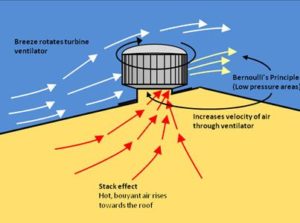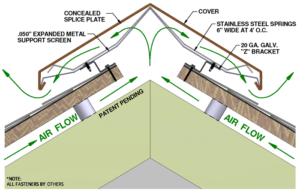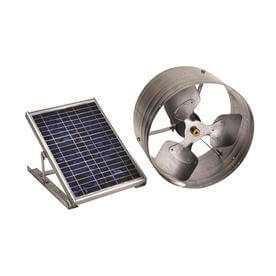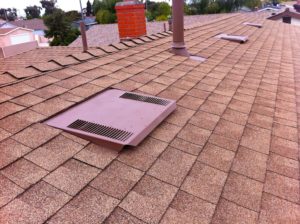Getting a roof ventilation system right is super important. It maintains proper airflow that helps control inside temperature. It also keeps things safe by ensuring the structural integrity of the house.
Roof ventilation systems keep moisture from collecting inside the house and causing condensation. Condensation, built up over time, can cause water damage in the attic and other parts of the house. In the wintertime, water buildup can freeze over, and ice dams can appear.
Ice stops proper ventilation which inhibits the ventilation system’s ability to mediate temperatures.
All roof ventilation systems work on the basic premise that air enters through the roof soffits and escapes out the rooftop. The airflow needs to be maintained to work well.
Most roofs have one of two basic vent types: The house either has a powered vent or a passive vent.
- Powered vents use electricity to push air in a certain direction or flow.
- Passive vents operate on the premise that air pressure buildups will drive air in and out of the roof.
Almost all homes have one of four different kinds of roof vents installed. Each has its own benefits. Let’s take a look at the four different ventilation systems and why people choose them.
1. The Low-Profile Ventilation System
The low-profile system is the most common on the market. Typically, low-profile vents have a slanted back that helps prevent the effects of external weather.It stops water and other debris that slides down the slope of the roof from making its way into the vent. Low-profile vents are also sometimes referred to as louvered vents.
They’re usually made from aluminum or galvanized steel. What’s great about louvered vents is that they provide around 60 inches of net free area for each vent.
These pre-fab vents come with holes so homeowners, builders, or contractors know exactly where to fasten them. Depending on the size of the house, multiple low-profile vents may be required.
For each 1,000 square feet of attic space, the home should have four vents installed. Most of the time they’re placed on the back slope of the roof facing away from the front yard or street.
This helps give a more uniform street appearance to the house. Some companies offer the ability to customize the vent to match a roof’s color or pattern.
2. The Roof Turbine Vent

That means less of them need to be installed on a large roof. They also still work well even during periods of strong wind. Wind pushes the slats on the turbine, which cycles air through and out of the attic.
It doesn’t take a lot to work. Over 340 cubic feet of air can be cycled with only 5 mph wind every hour. With faster winds, even more air is cycled. Because the turbines can move so much air fast, soffits need to be kept clear of any insulation or debris to avoid too much air from getting stuck in the attic.
When considering a turbine vent, know that not all roofs can accommodate them. They are already going to stick out a bit, so most people choose aluminum, so it doesn’t rust over time and look unsightly. They also need to be lubrication on a regular basis, so it doesn’t make noise while it’s running.
3. The Ridge Vent

A lot of homeowners love them because they’re not easily noticed. Unless you’re specifically looking, it’s hard to notice them from the street. There are no shiny metal objects sticking out of the top of their house.
The ridge vents are covered with the same tile, shingle or other roofing material that is covering the rest of the house. It creates a blended look with enough ventilation to keep air flow good.
Modern ridge vents are designed to prevent animals, debris or anything else from getting through. The only thing getting into the attic is air. In addition, because ridge vents run long length-wise, they give the property a nice, balanced air flow.
4. The Active Vent – Solar and Electric

This helps keep temperatures appropriate and save money on energy bills. It also saves wear and tear on HVAC systems. Obviously, one of the main drawbacks of electric vents is that they stop working if there’s a power outage.
Likewise, solar active vents could halt function if there is little sun for a prolonged period of time. Another potential concern is that, by not relying on the natural balance of passive vents, active vents risk pulling out heated or cooled air that’s intended to stay inside. That can make air conditioning and heating work harder for desired results.
One thing to keep in mind is that, the better the attic and home is constructed, the less owners will have to rely on ventilation systems. Good sealings on attics mean that hot or cold air won’t have a chance to infiltrate the living spaces.
Air conditioned or heated air will stay in the house and not leak into the attic as well. When deciding on a roof ventilation system, the climate, size of the house, roof shape, attic size, and other factors will play into the ultimate choice.
Owners will also make their purchase decision based on the style or aesthetic they want to maintain with their home or commercial space. Roof ventilation professionals often provide free inspections and estimates on different systems, so homeowners can make an informed decision.



